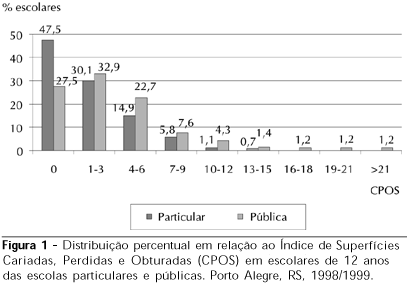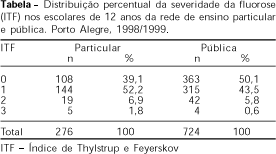OBJECTIVE: To determine the relationship between the socioeconomic status and dental caries, gingivitis and fluorosis among Brazilian school children. METHODS: One thousand students aged 12 from private and public schools were examined. The indexes used were DMFT or S (Decayed, Missing and Filled Teeth or Surfaces Index), BI (Bleeding Index), and TFI (Thylstrup and Feyerskov Index). The socioeconomic level was determined according family income and parents' educational level. RESULTS: Parents' educational level data revealed a strong Pearson's correlation with income. No correlation was observed between dental caries prevalence, gingivitis and fluorosis and the studied social economic variables. The DMFT in private schools was 1.54±2.02, and in public schools was 2.48±2.51. BI was 14.7%±12.7% in private schools and 21.7%± 17.9% in public ones. The prevalence of fluorosis was 60.8% and 49.9%, respectively). These differences were statistically significant (p<0.05). Individuals with a larger number of decayed surfaces and the ones with a larger percent of bleeding surfaces were seen in public schools. CONCLUSIONS: The socioeconomic level variables, income and parents' educational level, did not correlate with the events analyzed in the study. Other socioeconomic variables probably contributed to the observed differences between students from private and public schools.
Dental caries; Gingivitis; Fluorosis, dental; Socioeconomic factors; Students; Dental health surveys; School health; Cross-sectional studies; DMF Index; Educational status; Per capita income




